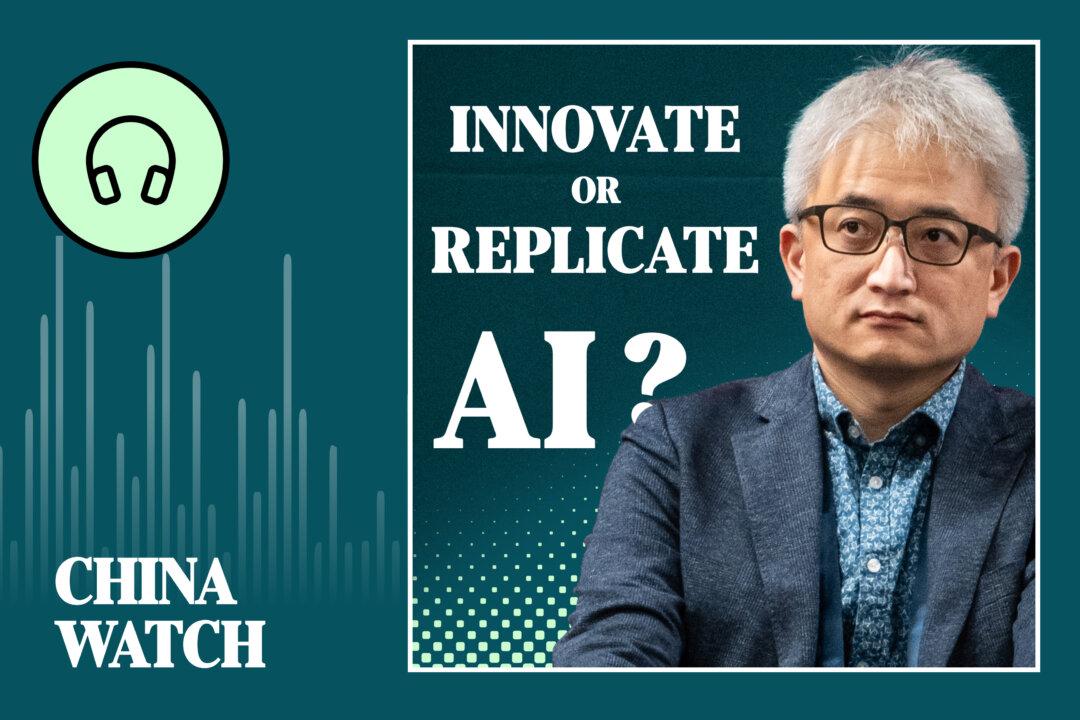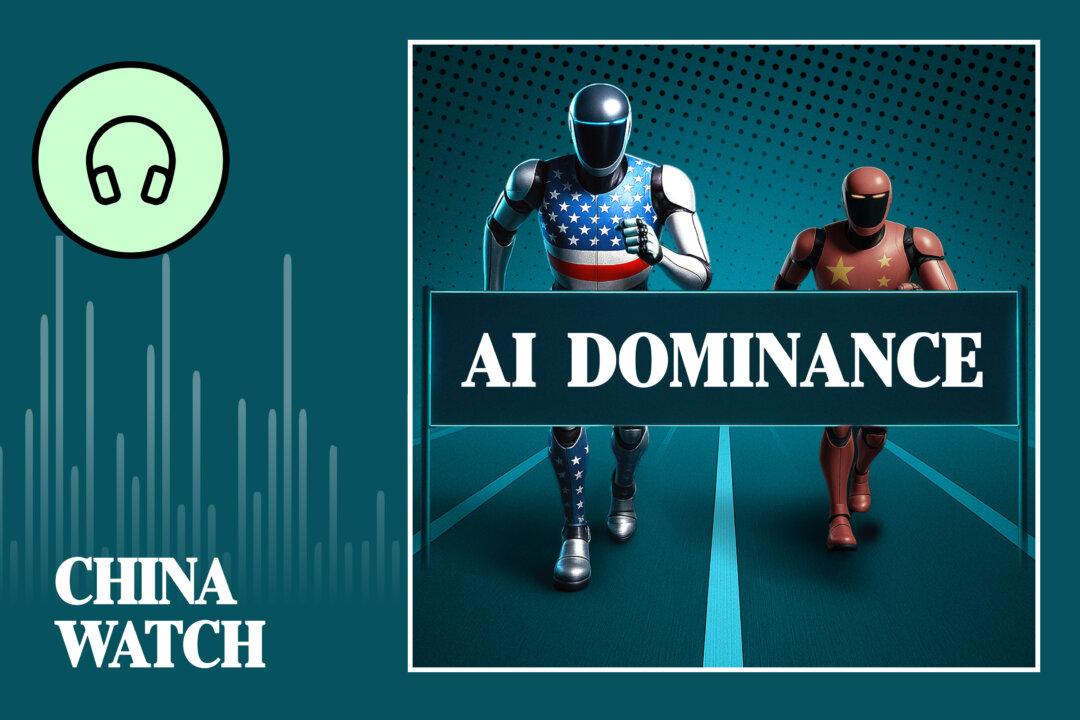Terri: Ethan, I know that you know the technology side of artificial intelligence really well. A lot of us are just kind of from the outside, and yes, AI is very cool, but it’s also kind of very hard to understand, especially to find out where the U.S. is versus China.
It’s very interesting that one of the exhibitors there had kind of a very simple voting mechanism, and so he had a jar where people vote for the U.S., and another jar for Beijing. And right now, the number of ping pong balls in each jar is basically about 50-50.
China has generated a lot of buzz recently with the humanoid robots’ half-marathon and the kickboxing competition.
How much of that is real, and how much of that is actually relevant in the U.S.-China AI race?
Ethan: So, if we look into the artificial intelligence innovation, if we look into the breakthrough technology, usually the United States will announce it first, then China will try to duplicate and promote it in a different way.
For example, in the United States, we have ChatGPT first. Then, have an open-source model like Llama. Llama is released by Meta. And China will try to—I will say, the expertise of China is: they will try to reproduce the technology in a very cost-effective way.
And also, they are good at promoting their technology because they have a nationwide propaganda machine to promote, for example, DeepSeek results.
So if we look into the technology, if the United States says, “Oh, we will use drones to deliver packages.” For example, if Amazon ever promotes drone delivery, China will also have a lot of drone companies do the drone delivery service.
The same thing happens everywhere.
So, for all the technology, like Uber, like Airbnb—there’s always a United States version. But then, there is a Chinese version. But they claim to have many more users, or it’s much more affordable, or they will promote it in a very special way.
For example, if there’s a high-speed rail, like Elon Musk announces the Hyperloop. China will say, oh, their Hyperloop will be faster than the United States’.
So China is like—they don’t create new specs. They don’t create new aerial competition. They add to the space of aerial competition that the United States initiates, and China will try to beat it in the matrix, in the benchmarks.
Terri: Yes, and some people say that’s where China’s advantage is. It is not necessarily good at breaking new technology, breaking new scientific discoveries. But it’s good at implementing.
What do you think? Some people say that now China has a bigger advantage because AI has moved to the age of implementation rather than discovery, and also the age of data versus algorithm.
Ethan: I will say, of course, at the very beginning of GPT, the large language model can be only hosted in the public cloud.
But later on, because of the open source technology developed, like Llama, Mistral. At Taiwan AI Labs, we also have our FedGPT. This kind of open-source technology is being deployed to edge environments at a more affordable cost. So it can fit into different kinds of industries, different scenarios.
But this transition is actually not initiated by China.
This is actually the nature of open source, and also the evolution of the technology will become more affordable and easier to be used in edge devices. So I won’t say that’s because China is good at optimizing it.
But like I mentioned, for the optimization of the AI algorithm, if there’s a benchmark, the United States claims the United States is good at something, and that can be documented.
China is always using… China is good at using the same evaluation data set and then trying to produce an AI model to win the best score.
So, I think this is like the education system in the United States.
We trained students to discover and to find the problem, to solve the hard question. But in China, they try to solve the problem already discovered, but in a more efficient way.
So it’s like a Chinese student who tends to have a higher score in the same test, but the test doesn’t mean everything.
Because the test is based on questions, you just need to answer the specific questions in the correct way.
Terri: Yeah, I get your point. But in terms of the Chinese advantage, if they’re good at taking a test that the U.S. has already preset and defined, then would they actually have the advantage to win the U.S.-China AI race?
That’s more important, right? Yes, maybe it doesn’t mean anything, but is there a way, or do they actually gain a meaningful advantage in beating the U.S. in the AI race?
Ethan: I will say, in artificial intelligence, because new areas of questions are actually discovered every day. Therefore, in the United States. I think a good thing [about] the United States is that they will, they can quickly discover a new question and solve it in a breakthrough way.
But once it is solved, usually China is good at optimizing the result, but it does not…
Because there are new areas of questions happening every day. Therefore, I won’t say that, because China’s artificial energy model solving the same question with a better score means the Chinese are doing better in artificial intelligence.
Terri: Because I think what you’re saying is that, in a way, China has always been playing on a stage that’s already set by U.S. technology and discovery and everything. Therefore, the fact that it may look like they’re doing better does not mean that they are actually better.
Ethan: There are a lot of applications that, if the academic team can set up a rule to evaluate the AI performance, usually, the Chinese team will publish a lot of papers and have a good score.
That’s good. But there are also a lot of unknown questions that haven’t been identified, haven’t been set up, and that part, usually the United States, is the first one to discover and to have a breakthrough result.
Terri: And so then, can I ask? Because you’re talking about the pioneer, right? Just being a pioneer doesn’t really guarantee that you will be a leader in the industry.
A lot of times, the front runner gets caught up by the latecomer, right? So, what would needs to happen for the U.S. to keep the leading position?
Ethan: I think in the United States, because the United States is very focused on the application of artificial intelligence, they don’t focus on test scores, per se.
As a result, you can see artificial intelligence being adopted by industry in a lot of different formats in the United States.
But in China, they tend to look at the United States: what kind of application is being used. Then, they will rank it according to the way the United States ranks it. And they will also solve the same questions.
So, in this way, I would say that if there are innovative ideas and innovative teams, that they find new questions to solve in China, it’s actually much more difficult to get funding.
Terri: Let’s talk about the voting I just described at one of the exhibitors. What do you think is the ratio of the U.S. leading China or China leading the U.S.? Is it 65-35, 55-45, or?
Ethan: The definition of leading is kind of misleading, because, from my point of view, if we say, discover new technology, have a breakthrough in AI models and also solving tough questions, like moonshot questions, so far, the United States is doing well; it’s not falling behind.
And if you look into the some essential technology, for example, manufacturing chipset or to train a model, like a open source tool, to train the model, the majority of the tool and also the majority of computing power, the supply chain, is still at the United States’ side instead of China’s side.
But so China gets a very good score, from my point of view, but it does not mean they are leading in technology.
If you say leading, I would say the United States is still leading in technology in terms of artificial intelligence fundamental open source, and also the application.
And China is leading in artificial intelligence in terms of model performance benchmark, and also maybe, like paper publications, because China has much more researchers publishing artificial intelligence papers. So their paper publication is quite a lot.
Terri: Let’s now talk about a different parameter. I’ve talked to some experts who said the U.S.-China AI race really comes down to the AI infrastructure. Because you can have better technology, but no one is using yours, everyone’s using the Huawei version of AI infrastructure, you know, then practically China can own the world in terms of AI with secondary technology. You don’t have to be the best in technology to dominate the world, right?
Ethan: I think, of course, the market adoption rate of AI technology is important for AI to continue to grow because more users use it, the company will get more revenue. The company can also develop more AI technology.
On the other hand, if China is good at manufacturing computing power, commodity hardware, of course, they may be leading in terms of market share.
Like right now, a lot of Android devices are developed by Chinese companies.
Market share also does not mean everything, because, for example, the Android phone coverage may be higher than that of the iPhone. But when we want to have a reliable device, we want to have a better experience device, you will still use the technology that’s been developed in a trustworthy and responsible area, usually it is in the United States.
Terri: So, part of the concern I think people have is that Chinese AI models don’t necessarily have the same ethical standards. So it could easily be a virtual reality where the Chinese communist values rule, and so what are your thoughts on that front?
Ethan: Yeah, that’s also one of the important issues we discovered.
Because artificial intelligence will become a superpower in the future, people will rely on artificial intelligence more and more.
Therefore, the ethics of artificial intelligence will be very important.
Where does it store the data? Will it leak your information? Will it use the information to go against humans?
Or maybe the larger language model is being injected with Chinese propaganda. That’s also what we discovered in the DeepSeek model.
Therefore, if we look into all of that. Actually, there’s a global effort to ensure trustworthy and responsible AI.
Regulation-wise, you can see, like in the United States, there’s an AI bill of rights.
In Japan, there’s also a regulation.
And also in the European Union, there’s an AI Act that tries to regulate the ethics of AI.
And there’s also a new ISO, like 42001, which is for AI ethics. Then, if we take all this into consideration, we can also discover that there are more and more industries when they consider using AI, including individuals, not only if it is affordable—their consideration matrix is not only the cost of AI technology, but also can we reliably trust this AI?
In Taiwan, for example, when we work with a hospital or a financial bank, they cannot use the general-purpose GPT language model. They need to use the financial, specially trained AI model that will answer the question, not following the regulation.
Terri: Okay. I bet you attended the Computex 2025 in Taiwan. Did you?
Ethan: Computex 2025? Yes.
Terri: It seems to me that Jensen Huang was presenting a whole ecosystem with partners and companies from democracies, and I don’t see any PRC companies in that ecosystem. So, how important is that? And of course, Huawei will have its own ecosystem.
And so, what do you think is the likelihood of who’s beating whom in the future? What are the key things to watch?
Ethan: There are more and more discussions about the supply chain integrity and supply chain transparency of AI.
In this way, naturally, China and the United States, their supply chains will diverge.
China will take China’s solution. The United States will take the United States’ solution.
So starting from the chipset, training, base model, to the training tool, to the high-speed computing servers, I can see the divergence of these two roads.
Also, democracy countries are controlling more and more powerful infrastructure. Therefore, if one of the elements cannot be trusted, the whole system cannot be trusted. Therefore, becoming a trustworthy partner in one ecosystem becomes very important.
Terri: For the normal people who aren’t that tech savvy, can you explain the AI supply chain? Of course, it involves hardware like chips, integrated circuits, computers, and high-performance memory chips. But are there any software parts of the supply chain?
Ethan: Of course, like the model training tool, and also the base model, like DeepSeek is a base model. Mistral is a base model. In Taiwan, we have FedGPT. Or TeminGPT is a base model.
Terri: And the base model defines the protocols and values in the AI world? Or what does it do?
Ethan: You can consider the base model is like… If you adopt this model to use in your company, you can consider that you are hiring an employee. He has graduated from a Taiwan university, or he has graduated from a United States university, or he has graduated from a Chinese university.
A lot of times, you can hire graduates from other countries. But if in another country, they train their model in a different ethics, or a different rule, or maybe they inject some cultural bias. We need to be very careful because the model may work for authoritarian countries.
Terri: And that model can potentially, at some point, when we get to super-intelligent AI, that model can steal the other AI’s technology?
Ethan: I’d say the model is like a human. You will learn from the data the way you train it. Therefore, if you train it with the data that does not say Taiwan is a country, of course, the answer is—Taiwan is not a country.
If you train it in a way that when you talk about Uyghurs, you will avoid talking about this topic, then this model will also avoid talking about this topic.
So that is a cultural bias, the content censorship issue, and you will train a model to support you to write the program, and if you always inject, like a backdoor program— your training data, that means the model that helps you to write the program will also inject the backdoor.
Terri: And inject a battle?
Ethan: Backdoor.
Terri: What’s that?
Ethan: Backdoor, the security backdoor, which means maybe the hacker can leverage the backdoor to get into your system.
It’s like when a company hires an employee. You need to do the background check. And a lot of the ethics considerations can only be identified by the background check.
At this time, then you don’t use the base model. You choose to use the base model you trust.
Terri: Last question, overall. How much is China behind the U.S.? I think Nvidia talked about it in months, and some experts talk about in years.
Ethan: I think what Nvidia said is the chipset technology, and Jensen Huang sees the chipset technology in China is only months behind the United States.
I’m not an expert in that area, but from my observation, I haven’t heard about any team using Huawei’s chipset to train AI models.
At least in the team in the United States or in Taiwan. For teams in China, probably. But a lot of propaganda about China’s technology is near that of the United States, or is even more advanced than that of the United States.
We’ve heard about that many times. Well, I will stay suspicious and cautious.
Terri: Back to your point: this outperforming the U.S. was done in the preface of repeating what the U.S. has already done. Therefore, it’s kind of in a twisted or very confined scope that China is doing better than the United States.
Ethan: From my understanding, it’s very difficult to outpace the U.S., find a software stack at this moment, in terms of artificial intelligence.
But, for the number of paper publications or maybe the model performance scoring, China can do better. I think that’s for sure, because China is good at that, you know.
Terri: Great. Thank you very much.
Again, that was Ethan Tu, the founder of Taiwan AI Labs.
This was a special extra episode of China Watch. We are on Apple—search for “China Watch Epoch Times.”
This podcast is a weekly production with new episodes every Monday evening. Support independent journalism by subscribing to The Epoch Times!
*This transcript was edited for brevity and clarity.






